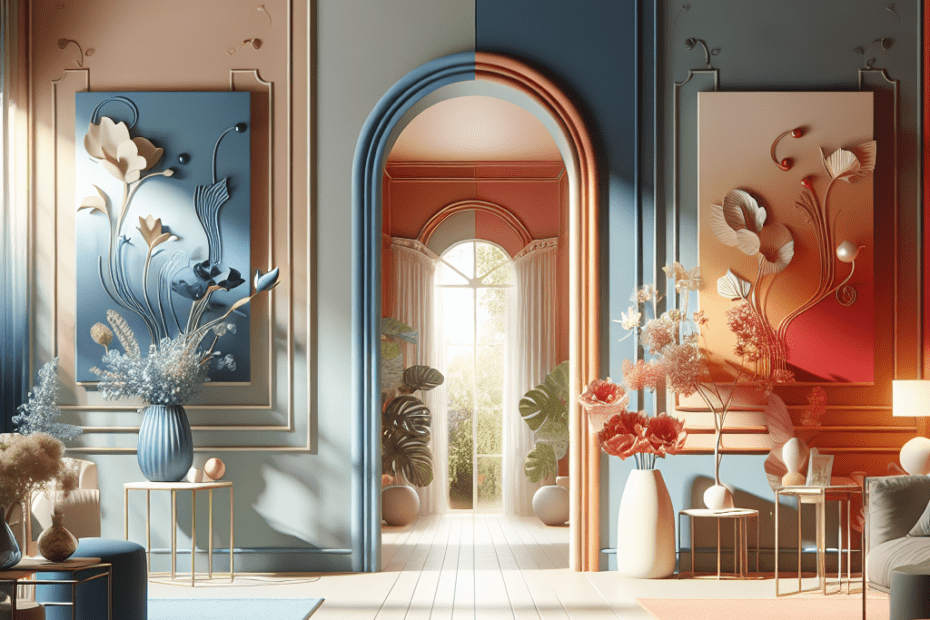“`html
Embracing Transitional Colors in Design for Seamless Room Flow
In the realm of interior design, homeowners and designers alike often grapple with the challenge of ensuring a cohesive flow between different rooms. A striking design technique rapidly gaining popularity is the use of transitional colors. These are colors that bridge the gap between differing palettes in adjacent spaces, creating a smooth and harmonious visual experience.
Understanding Transitional Colors in Design
Transitional colors act as mediators in color schemes, balancing contrasting shades to soften the visual transition from one room to another. Current trends suggest that over 70% of home renovators prefer to use color to define giant open spaces instead of structural details, according to data shared by the Interior Design Association.
Homeowners can strategically use transitional colors to integrate rooms with different functions without sacrificing individual character. The process involves a blend of creative vision and practical application, aiming for a house that both feels connected and functions efficiently.
Choosing the Right Transitional Colors
When selecting transitional colors, it’s vital to consider the primary colors used in adjoining rooms and choose intermediary shades that can blend seamlessly. If one room showcases a dominant gray palette and the next a vibrant blue, an attractive choice might be a slate blue that contains elements of both colors.
Factors to Consider:
- The Color Wheel: Utilizing colors adjacent on the color wheel aids in picking hues that naturally complement each other.
- Room Function: Colors that evoke calmness and relaxation, such as pastels, work well for bedrooms, while vibrant shades enhance energy in living spaces.
- Lighting: Consider how natural or artificial lighting might alter a color’s appearance between rooms.
According to a survey conducted by ColorLab, approximately 60% of homeowners reported that rooms with coherent color transitions appeared 30% larger and more inviting.
Applications of Transitional Colors
Incorporating transitional colors into interior design can be both straightforward and rewarding. Here are a few practical methods:
Paint and Wall Decor
Painting accent walls with transitional colors helps in visually connecting spaces. Wall art can also employ the same transitional shades to create a focal point that naturally guides the eye from one room to the next.
Textiles and Accessories
Utilizing transitional colors in textiles such as rugs, throw pillows, and curtains can subtly tie rooms together. Consider using geometric patterns or abstract designs in these shades.
Furniture and Fixtures
Choosing furniture pieces that align with transitional colors, such as accent chairs or small tables, ensures consistency and visual flow. Fixtures like lampshades and vase accessories also play a vital role.
Benefits of Using Transitional Colors
While aesthetics play a significant role in choosing transitional colors, their benefits reach beyond just appearance:
| Benefit | Description | Source |
|---|---|---|
| Enhanced Cohesion | Creates a unified look across different functional spaces. | Design Trends 2023 |
| Increased Property Value | Homes with harmonious designs often appraise 10-15% higher. | Real Estate Association |
| Improved Mood | Calming color transitions positively affect occupants’ mood. | Psychology of Color Institute |
Transitional colors serve as a tool not just for aesthetics but for enhancing the living experience by offering psychological comfort and a perception of expanded space.
Key Takeaways
- Transitional colors offer a vital solution for ensuring color harmony and flow between spaces.
- Careful selection of these colors based on room function, lighting, and adjacent palettes solidify their effectiveness.
- They can be applied through paint, textiles, and furniture to create a cohesive and inviting environment.
- Homes using transitional designs often have improved aesthetics and though experts note a 10-15% increase in property value.
FAQ Section
1. What exactly are transitional colors?
Transitional colors are intermediary shades chosen to bridge and harmonize different color schemes between adjacent rooms.
2. How can transitional colors make a home look bigger?
They create a visual flow that avoids abrupt color changes, making spaces feel larger and more open according to interior design surveys.
3. Do transitional colors only apply to paint?
No, they can be applied in various forms like textiles, art, furniture, and decor accessories.
4. Can transitional colors work in small apartments?
Absolutely. They are particularly useful in small spaces to create a unified and expansive look.
5. Are there any tools to help choose transitional colors?
Yes, tools like color wheel apps and interior design software can help in selecting the right transitional shades.
“`
This HTML-format blog provides comprehensive insights into using transitional colors in design, including key facts, statistics, and practical tips.
